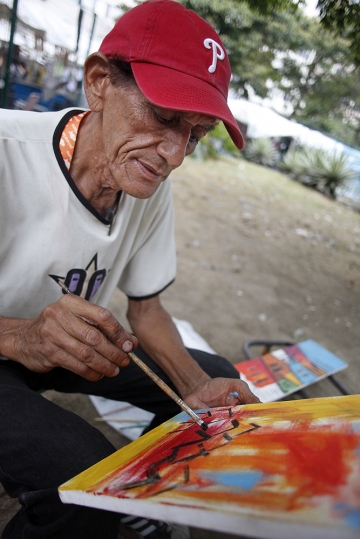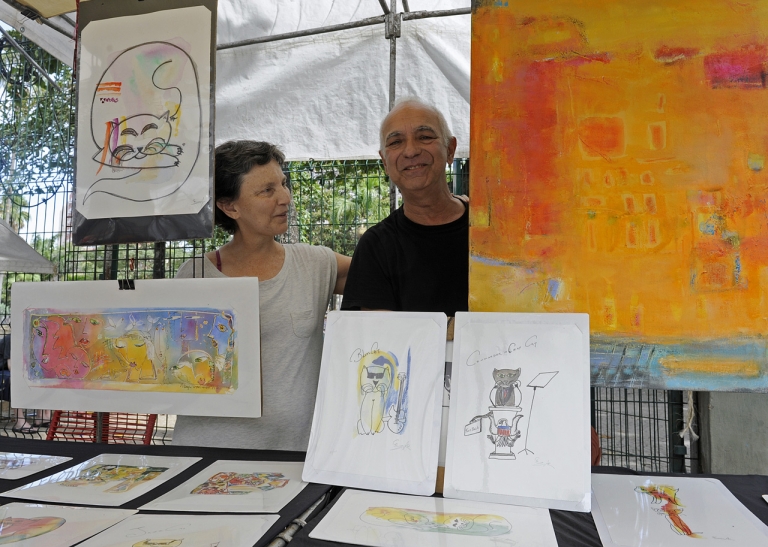ComMedia in Brazil: The blog
Students from Comm 402 International Reporting share their experiences while doing field work in Rio de Janeiro during Spring Break. View more photos in ComMedia in Brazil: Scenes from Rio.
Soccer merges with volleyball on Rio's beaches
Brazilians are passionate about soccer. Some people say it’s is not a sport, but a type of religion for them. In Rio de Janeiro people have taken soccer to the beach and invented a new and more acrobatic sport.
They call it “futevôlei.” Similar to beach volleyball, futevôlei has a net in the center of the court. But the net for futevôlei is a foot lower than it is for beach volleyball.
 Futevôlei players use their head, feet, knees, ankles, thighs, and shins to pass and spike the ball. Hands and arms don’t come into play. The sport is played with 2 or 4 players on each side. Teams play three sets of 15 points with a difference of 2-point margin needed to win.
Futevôlei players use their head, feet, knees, ankles, thighs, and shins to pass and spike the ball. Hands and arms don’t come into play. The sport is played with 2 or 4 players on each side. Teams play three sets of 15 points with a difference of 2-point margin needed to win.
One of the first nets hung exclusively for futevôlei in the world is called Maracanã, at Rua Constante Ramos at the Copacabana beach in Rio.
Selmo Tarnopolsky, 58, is a pioneer in futevôlei and director of futevolei.com.br. He said that the sport might be fairly new in other South American countries and in Europe, yet its history in Brazil can be traced to the late 1960s. Back then all sports were prohibited on the beach before 2 p.m.
“Professional and former soccer players at the time would bring a soccer ball and would shoot on a goal post, also people would pass and kick the soccer ball on the volleyball nets on the beach,” Tarnopolsky said. The city and the police eventually hung a net and the sport was born.
Watching from his bike on the sidewalk was Otavio Gomes, 85, who goes to Copacabana beach to play futevôlei almost every weekend. He has been playing futevôlei since 1976 on weekends at the Maracanã net and explained how the sport first got the attention of Cariocas, Rio natives.
“In 1986 famous soccer players started playing it, so the sidewalks in Rio got crowded. It was a spectacle -— they would play from four in the afternoon until late night during the week,” Gomes said.
 With acrobatic moves such as bicycle kicks and shoulder passes, futevôlei has grown exponentially over the years, reaching all 26 states of Brazil and the federal district, too.
With acrobatic moves such as bicycle kicks and shoulder passes, futevôlei has grown exponentially over the years, reaching all 26 states of Brazil and the federal district, too.
Women got involved playing futevôlei a couple decades after the sport was created. “It’s another attraction. They started in the 1980s when a lot of professional soccer players participated with us, so they became curious and excited to try it, too,” Tarnopolsky said.
On this day Women can be seen playing at the other end of Copacabana. Teacher Rodrigo Leite Vasconcelos, known as “Café”, offers futevôlei classes at a net near Post 6. Participants can choose to play on Mondays, Wednesdays and Fridays from 8:30 until 10:30 a.m. There are also evening classes from 7 to 9 p.m.
Maria Regina Perreira Lima, 47, is one of the students and says she never misses one of the 2-hour workouts.
“Practices keep me in shape to take care of my two young children,” she said.
Here's video made at Copacabana beach of players at the Maracanã net.
-- Text and video by Eric Teixeira Visintainer
Still photos and video by Chloe Elmer
Making a sacrifice to experience true life in Brazil
When I found out I was going into an unpacified favela -- a Brazilian slum controlled by drug traffickers rather than the government -- to shadow a young woman named Paloma Cristina Terra, I admit I was a bit uneasy. I had heard stories about the everyday violence that occurred within these communities, about journalist kidnappings, about frequent and deadly shoot-outs. The police generally don’t go there at all. Ambulances and taxis don’t usually go there, either. In my mind, this was kind of like a war zone.
To compound my unease, we were told we had to go in under a strict set of guidelines. An employee from the project I am writing about would have to escort us at all times, and it was suggested that we wear shirts with their logo to identify our association. Also, our cab would have to be led through the narrow streets by their easily recognizable truck as yet another precaution.
I thought, “What on earth have I gotten myself into?”
 But what I found when I arrived was much more than just a dangerous neighborhood living off the grid from mainstream society. What I found were some of the most generous and loving people I have ever met.
But what I found when I arrived was much more than just a dangerous neighborhood living off the grid from mainstream society. What I found were some of the most generous and loving people I have ever met.
We arrived early Tuesday morning at the home of Paloma’s friend, Monique Gomes, because Paloma was having a sewage problem. (Many people in the favelas do not have legal water, sewage, or electricity. They often jerry-rig their homes in order to have these amenities, or they don’t have them at all.) Monique was getting her three children ready for daycare and Paloma was tending to her infant daughter. We were served coffee and told to make ourselves comfortable in the small, yet well-kept apartment.
Soon after, Monique handed me a grilled ham and cheese sandwich for breakfast, a common food in Rio. But for me, this created a problem. I am a vegetarian, and before me stood a woman extremely proud to feed meat to her American guest. I was really torn. What do I do? Do I stick to my principles and say no, or do I eat the sandwich to show my appreciation?
I first tried to pretend I was too busy to eat, but soon Monique started to look disappointed and asked me what was wrong. This wasn’t one of my friend’s houses. This was a completely different situation, one I had never encountered before. Could I really waste food from someone who probably didn’t have an excess of it in the first place?
 In the end, I took a deep breath and then my first bite. I tried desperately to avoid showing the mental pain quickly over-taking my body. Thankfully, it must have worked because Monique’s discontent was soon replaced with pleasure, and this experience turned out to be a defining moment that day. We broke bread together by sharing a meal, and it created a bond that would last well beyond our parting.
In the end, I took a deep breath and then my first bite. I tried desperately to avoid showing the mental pain quickly over-taking my body. Thankfully, it must have worked because Monique’s discontent was soon replaced with pleasure, and this experience turned out to be a defining moment that day. We broke bread together by sharing a meal, and it created a bond that would last well beyond our parting.
Later in the day, as we walked through the Jacaré neighborhood, a small group of females started to gather outside a home. They were friends and relatives of Paloma and Monique, and they motioned us over for a water break. Under the extreme heat of the afternoon sun, we passed a communal glass of water from person to person and shared stories, conversation and laughter. As we talked, I realized I felt completely comfortable standing on the street engaging in something so real and so welcoming.
We returned to Monique’s home, shared our life stories and the day started to wind down. One of the children curiously milling about outside gave us frozen passion fruit popsicles. As we stood saying good-bye, a sense of sadness enveloped me. I realized how much I was beginning to care for these wonderful women and their community. Not only was I no longer nervous to be in the favela, but I really didn’t want to leave.
 As the young women walked us out, down the steep green and yellow painted stairs and through a small concrete courtyard, we found some of the children playing ping pong in an alley. The table was made from a scrap sheet of laminated wood and the “net” was simply a chunk of concrete. One paddle was made from a broken tile, the other a small unfinished piece of wood. But the children didn’t care about their meager arrangement, and they eagerly asked us to play.
As the young women walked us out, down the steep green and yellow painted stairs and through a small concrete courtyard, we found some of the children playing ping pong in an alley. The table was made from a scrap sheet of laminated wood and the “net” was simply a chunk of concrete. One paddle was made from a broken tile, the other a small unfinished piece of wood. But the children didn’t care about their meager arrangement, and they eagerly asked us to play.
I lost miserably to my 4-foot-tall, shirtless opponent, a boy of about 10 years old, who was giggling at my poor skills from the other end of the makeshift table. As we played, though, I felt a sense of openness I realized I rarely felt in the stuffy communities in America, a country often too obsessed with material things to stop and smell the roses. It struck me that what I had just been a part of on this day would be a cherished memory forever because unlike most tourists, I had been given the gift of experiencing a true part of life in Brazil.
-- story by Jen Swales, photos by Jill Knight
Buckle up … and I mean it!!!
Stepping into a taxi cab and trusting a driver you've never met before takes a small leap of faith. My fellow Americans reading this who have ridden in a New York taxi at rush hour probably think nothing is scarier than that.
 I shared this misconception until taking a cab ride in Rio de Janeiro.
I shared this misconception until taking a cab ride in Rio de Janeiro.
I was riding across the south zone of Rio from Ipanema to our hotel in Flamengo with three of my classmates. The driver motioned for us to put on our seat belts as soon as we got in. Unfortunately, I had to sit in the middle where there was no seat belt and my other two colleagues on either side me couldn’t find the connectors to secure their buckles. Only our classmate in the front seat was securely buckled in.
It was evening and traffic was light, but apparently our cabbie thought he was in the Daytona 500 or something because he didn't seem very interested in obeying traffic signals. I can only recall two times that he slowed down significantly, one of which was when he dropped my colleagues and me off at the hotel.
My experience was not unique. All of my colleagues seemed to have a taxi story.
One of my classmates told me about a cabbie she had who was weaving through traffic and pedestrians while simultaneously watching video on a small television screen attached to his dashboard.
There aren’t enforced traffic laws as much as there are traffic customs here.
Some of the driving habits are related to the high crime rate. For example, ignoring stoplights (particularly at night when there is no one around) is common because many drivers are afraid of being robbed while idle.
But other habits seem to exist because driving is considered a game in Rio, with each motorist trying to make a move before the person coming up behind them does. In this game a cab ride is a lot like the Brazilian martial arts form, Capoeira. With all of the rapid movements involved, the idea is to come as close to the opponent as possible without ever actually touching them.
And don’t let a cab get behind someone who isn’t driving fast enough. Before they even consider slowing down, they will take the tiniest opening between two vehicles in front of them, leaving just inches of space to maneuver, and will lay on the horn until they have passed the slower driver.
Honestly, how these cabs fly down some of the narrowest streets in town without hitting anything is amazing!
It’s not surprising that Brazil is ranked third behind El Salvador and the Dominican Republic for the worst road death rate per person in the Americas. There are about 24.2 people killed in car crashes for every 100,000 members of Brazil’s population. About 35,000 people are killed on Brazilian roadways each year.
Despite these numbers, for our group this system worked. More people were bitten by sand fleas (three) than were involved in car crashes (zero).
But we were mindful that every time you take a seat in a Rio cab, it's at your own risk.
-- story and photo by Kyra Nelson
Favelas provide unique vistas in Rio

Rio de Janeiro is full of beautiful beaches, elaborate skyscrapers and elegant gated apartment buildings. When I turned my head one way, it reminded me of New York City with the busy streets and taxis flying by. When I looked the other way, I felt like I was in Miami with the scantily clad men and women strolling the beaches.
 But when I looked beyond the high rises or across the white sand of Ipanema Beach to the hills beyond, I saw houses stacked upon houses. These neighborhoods, called favelas, are where the lower class lives in Rio.
But when I looked beyond the high rises or across the white sand of Ipanema Beach to the hills beyond, I saw houses stacked upon houses. These neighborhoods, called favelas, are where the lower class lives in Rio.
It was unbelievable to see the rich and poor living so close to each other. Up close, the favelas are a mix of working class families and sometimes extreme poverty. From a distance, the favelas do give the city a sense of unique beauty. The colorful, mix-matched bricks or whatever else the people could find to build there houses look like pieces of art.
So many questions went through my head when I saw this way of life. Is it something that Brazilians talk about? Do they feel the favelas are dangerous? What kind of relationship do the rich and poor have together? Luckily, most of these questions were answered for me when I went to the American School in Rio. As we were driving up the narrow, winding road of the mountain, I noticed a large favela, Rocinha (pronounced ho-SEEN-ya), right next to the school.
The campus was built around a rainforest, so essentially the entire school is outdoors: hallways, lunchroom, gym class, etc … When the students are walking around campus, their scenic view is a favela.
 The principal, Erich Heise said, “Isn’t it ironic that the richest school in Rio is next to the largest favela?”
The principal, Erich Heise said, “Isn’t it ironic that the richest school in Rio is next to the largest favela?”
I couldn’t believe it. In the United States, I felt this would never happen, because it can be dangerous when people who have very little are so close to people who have so much.
Joy Ernanny graduated from the American school five years ago. She said safety was never an issue. “We always felt very safe because all workers (bus drivers, cleaning staff, secretaries, etc) in the school, other than teachers came from the favela,” Ernanny said, “so the community was very grateful to the school for employment and for all the help.”
Leaving the school that day changed my perspective of the class system in Rio. The school and the favela work together as one because they wouldn’t survive without each other. “We are like a family,” Heise said.
-- story by Kelsey Penna, photos by Kelsey Penna and Cassie Hom
Samba night
Rio de Janeiro is well known for its vibrant beaches, growing economy and obsession for soccer. However, one of the most unique things I will take away from this international reporting trip is the people and their love for music.
I spent most of my time in Brazil working as a reporter. Before leaving, I wanted to experience Brazil as one of the locals. On Friday night, a fellow reporter and I took the opportunity to accompany Lee Weingast, an English teacher and interpreter, to a historical site called Pedra do Sal. Otherwise known as “salt stone,” Pedra do Sal was originally a port where boats unloaded salt shipments in the early 17th century. Located in the Centro neighborhood, it also served as a market where salt was used to purchase slaves. Over time, a community of African immigrants from Bahia who settled in the surrounding area met here for social events. They cooked African quilombo dishes and followed Bahian traditions such as the religious practice Candomblé. Fast forward to today, and now this former “Little Africa” square serves as a mecca for lovers of samba on Mondays and Fridays.
Widely believed to be the birthplace of samba, this popular roda de samba, or ‘dance circle,’ is a place where Brazilian natives gather to listen to musicians play authentic Afro-Brazilian samba. As we rounded the corner of Rua Argemiro Bulcão, I was shocked by how many Cariocas (Rio natives) were packed into this square.

I’ll be the first to admit that I was extremely intimidated as I navigated my way through the crowd with my heavy camera equipment. Luckily, Weingast led us to a bench next to the Samba de Lei band. After awkwardly teetering on top of the bench, I finally stood up and looked around. The sights and sounds of that view are indescribable. Imagine going to a massive, foreign block party where people of all races, ages and statuses energetically dance and sing to samba rhythms. That’s what roda de samba is at the Pedra do Sal.
 As I photographed the scene I found myself dancing along to the music with a woman named Renata Frazão. A 26-year-old lawyer, Frazão came to Pedra do Sal to unwind after a long day at work. She said all of her friends were here to listen to the samba musicians. She added that she enjoys the samba music and even participates with the band by playing a bead instrument.
As I photographed the scene I found myself dancing along to the music with a woman named Renata Frazão. A 26-year-old lawyer, Frazão came to Pedra do Sal to unwind after a long day at work. She said all of her friends were here to listen to the samba musicians. She added that she enjoys the samba music and even participates with the band by playing a bead instrument.
What I found most interesting was how much the people value the tradition of samba. Weingast said that although these nights are a nice way for the locals to kick back and relax with a cold beer, they have a strong awareness of the historical significance behind the Pedra do Sal. The musicians strictly strayed away from playing modern samba and instead performed old, traditional Afro-Brazilian music to honor the original samba roots. Their passionate appreciation for the Afro-Brazilian culture unites the people. As the hour came to a close, I couldn’t help but feel like one of the locals. That’s the beauty of the roda de samba. Whether it’s your first experience or 50th time going to Pedra do Sal, the music and energy transports you into becoming a part of authentic Brazilian culture.
Listen to a sample of authentic Afro-Brazilian music played that night by the Samba de Lei band:
-- Story, photo and audio by Cassie Hom
Learning to work smart
As a photojournalism student, State College seems to be a very safe place to work with a camera.My colleagues and I carry cameras around on a daily basis, thinking nothing of it.
The fact that I have a high-quality digital SLR camera with me all the time makes me jaded to the fact that it is quite valuable. The idea of someone coming up and stealing my camera while it is attached to me is just about the last thing on my mind.
Traveling to Rio de Janeiro, Brazil, with my international reporting class completely flipped my idea of comfort while carrying a camera.
On arrival I acted like I normally would while shooting in State College, walking around with my camera around my neck, ready to snap photos as I saw things in front of me. I had a padded black backpack that carries camera equipment as well. I’m the type of tourist who does not normally wear backpacks around because I try to blend in as much as possible, but it’s hard to carry camera equipment around safely and blend in. I also wanted to make sure the equipment was properly protected while walking to assignments, because when I was in London two summers ago I tripped and fell, causing my camera (which had been just placed in my purse) to fall to the ground, breaking the lens that I needed to use for my internship. The equipment I brought to Rio was owned by Penn State, but I would have to pay for it if it got stolen or damaged. The only way to protect the equipment I needed was to tuck it in the proper carrying case, making everything not so subtly hidden.
I first brought my equipment into a favela on the west side of town on Sunday. Favelas are shantytowns in Rio that originated as squatter settlements. Tourists are warned of the crime and are advised to stay for only a few short daylight hours if they go in at all. Since many of the stories came out of favelas, we were in them often. Within minutes of stepping into the favela with my backpack that first day, I knew it was a mistake. Our group was often gawked at on the street because of our different looks and differences in skin color anyway (untanned skin really stands out), but carrying this backpack especially made me feel like a target. I knew I needed to lighten up my equipment and not take out my camera (even on the Metro) until we arrived to our destination.
Even though it sounds easy enough to just put your camera away until you have to work, it is not that simple for photojournalists.
“Having to hide my camera when I’m seeing such visual things is the hardest thing for me to do,” said colleague Kelley King, who often had to carry a monopod around for video recording as well.
King is working on a story with a classmate about an American making a name for himself as a performer of the "funk" music trend popular in Brazil. She wanted to go to one of his performances in a large favela. She was told by the artist not to take out her camera until she arrived safely in the club where he was performing.
Photojournalists see light and people in patterns, shapes and color. It’s impossible for us to not want to take photos along the way, especially in a city like Rio, where everything feels like it is just waiting to be photographed. From graffiti to shopkeepers to the metro to children playing in the streets, everything was fresh and interesting to our eyes.
Though we initially had our cameras out on the first day or two to capture these sights, we quickly learned that was not the thing to do. People and shopkeepers from the area who didn’t even speak a lick of English approached our group just to warn us of the dangers of keeping our cameras out. One woman even had to communicate to me in Spanish because she didn’t speak English. Though it made everyone hyperaware of the prevalence of crime in the area, as an outsider, it was nice to have the tip. The people who helped us could have easily just gone about their day and seen us as naive tourists. Instead, they cared and helped.
Professional photographer Doug Engle, who is based in Rio, deals with this conflict on a daily basis. Engle said that although he doesn’t walk around with his camera visible all the time, it is rare that he doesn’t have some kind of camera on him at all times.
“I use regular generic backpacks and only get out the camera when I want to use it,” Engle said.
The lesson to be learned here is simple; discretion. Don’t be overly noticeable, and try to blend in as much as possible, even if that means traveling light and keeping your camera out of sight.
I don’t blame Brazil for making me feel uncomfortable having my camera visible. The cameras we use look flashy and expensive, which is something that a common criminal in any country would want to steal. It even makes me wonder if I should be more careful while in State College.
-- by Chloe Elmer
Among my own, thousands of miles away
The highlight of my trip to Rio, hands-down, was attending a Purim holiday performance by a wildly popular Jewish band that plays Beatles cover songs infused with Brazilian music. But it was another event – a simple Shabbat service not much unlike the ones I attend back home (aside from the very casual dressing here) – that made me realize something: No matter where I am, being with other members of my tribe evokes warm memories of family, friends and growing up and allows me to reconnect to the religion that is a large part of who I am.
 From the second we stepped out of the cab by the Reform synagogue here and a congregation member chewed out the driver for overcharging us, I felt at home even though I was more than 4,000 miles away. Just like my grandmothers, mother and aunts have been known to do, the women at the synagogue – young and old alike – began hovering around me insisting I try every baked good being passed around. I should mention that the assortment was varied and included potato knishes, apple strudel, rugelach and caramel layer cake. Any wonder I felt as if it were the Jewish holidays back at my grandparents’ home?
From the second we stepped out of the cab by the Reform synagogue here and a congregation member chewed out the driver for overcharging us, I felt at home even though I was more than 4,000 miles away. Just like my grandmothers, mother and aunts have been known to do, the women at the synagogue – young and old alike – began hovering around me insisting I try every baked good being passed around. I should mention that the assortment was varied and included potato knishes, apple strudel, rugelach and caramel layer cake. Any wonder I felt as if it were the Jewish holidays back at my grandparents’ home?
The similarities did not end there. As soon as we arrived at the synagogue, our hostess paraded us around as if we were some sort of prized trophy from the United States. This is nothing new to me, having grown accustomed over the years, at any holiday gathering or celebration, to having someone in my family introduce me to every single third cousin and any “nice Jewish girl” in the vicinity. And if that someone making the introductions happens to be my mom, I can't go anywhere without her reminding anyone who may not yet had heard: "Did you know Alex is the sports editor for the Collegian?"
OK, I admit it was a struggle at times keeping my eyes open during the service here, as it often is at home. But while it may not be as much fun as clubbing or sightseeing, attending a two-hour prayer service does give you a good sense of your roots and heritage.
 On this particular Friday evening at Associação Religiosa Israelita, the Reform synagogue in Rio de Janeiro, two young boys about to be Bar-Mitzvahed were up on display, sitting beside the rabbi on the podium. Observing them, I couldn't help but help but remember experiencing that horrifying situation myself. Like me at 13 (and even today, if you ask most people), one of the boys was gawky and skinny. The other seemed pretty restless. I caught a glance of one of their mothers staring at her son with the same twinkle in her eye that my mother had in hers nine years ago. Seconds later, after he stuck his tongue out to let her know just how bored he was, she gave him that same angry stare my own mom gave me for similar antics nine years ago. When it came time for them to read aloud in front of the congregation, I could close my eyes and recall the sound of my own high-pitched cracking voice at that age, which I've been forced to hear many times since on that nightmare known as the Bar-Mitzvah video.
On this particular Friday evening at Associação Religiosa Israelita, the Reform synagogue in Rio de Janeiro, two young boys about to be Bar-Mitzvahed were up on display, sitting beside the rabbi on the podium. Observing them, I couldn't help but help but remember experiencing that horrifying situation myself. Like me at 13 (and even today, if you ask most people), one of the boys was gawky and skinny. The other seemed pretty restless. I caught a glance of one of their mothers staring at her son with the same twinkle in her eye that my mother had in hers nine years ago. Seconds later, after he stuck his tongue out to let her know just how bored he was, she gave him that same angry stare my own mom gave me for similar antics nine years ago. When it came time for them to read aloud in front of the congregation, I could close my eyes and recall the sound of my own high-pitched cracking voice at that age, which I've been forced to hear many times since on that nightmare known as the Bar-Mitzvah video.
So even though I doubt this experience will have me rushing to Hillel services as soon as I get back to Penn State (not even 10 days in Israel could do that), my week of rather intense immersion into Jewish religion and culture in this land of samba and soccer has brought me closer to my heritage. And the brownie points I’m sure to earn with my mother and grandmother can't hurt either.
-- story and photos by Alex Angert
An Extraordinary Sunset
The day started out just like any other here in Rio. I woke up early (mostly to physically show my professors that I survived yet another Brazilian night), sent a few e-mails, made a few phone calls, and was sweating (both literally and figuratively) the day's upcoming interview due to its potential to make or break my story.
A Brazilian adventure was not on my busy to-do list for the day, but it happened anyway.
As I wrapped up my 4 o'clock interview with Julia Michaels, the creator of RioRealBlog.com, she invited me and another journalist to a walk along nearby Ipanema Beach, one of Rio's most famous destinations.
It seemed like a nice gesture. But I soon realized that I wasn't going to just feel the warm, Ipanema sand between my toes; I was going to witness an indescribable sunset – a sunset that is so breathtaking that it is part of Brazilian tradition to applaud its beauty each night.
 As the sun began to dip toward the horizon we walked up the trail to Arpoador Rock to get a better view of the sunset. I whipped out my iPhone, tapped the camera app, looked at the screen and realized why the cariocas (locals) applaud sunsets, and snapped a photograph.
As the sun began to dip toward the horizon we walked up the trail to Arpoador Rock to get a better view of the sunset. I whipped out my iPhone, tapped the camera app, looked at the screen and realized why the cariocas (locals) applaud sunsets, and snapped a photograph.
The sun here doesn’t set on the ocean, it sets directly between two mountains called Dois Irmãos, or Two Brothers. The thick rays of orangey-glow dance off the sides of both mountains and illuminate the ocean, the beach and the skyline of Ipanema.
As I took a minute to soak in this unrivaled event, the glow began to fade, the applause ended and I was left there on top of Arpoador Rock with my jaw permanently cemented to the ground.
-- photo and story by John Andreadis
Barra offers the wealthy a modern alternative to traditional Rio life
While walking around Flamengo, the Rio de Janeiro neighborhood we stayed in, I could feel the European influences meshing with the Brazilian culture in the architecture and flow of the city. The streets are small and many are cobblestoned; the buildings are older and colorful; people are dressed casually, always ready to go to the beach. But a half-hour from Flamengo (or three times that long if you’re traveling during rush hour), Barra da Tijuca offers a completely different Rio de Janeiro.
 An area that is often compared to Miami Beach, Barra da Tijuca is full of high rises, fitness centers, shopping malls, car dealerships and American stores. Driving through the neighborhood I saw a Blockbuster, McDonald’s and even a store called American Pets. We passed Mercedes, Fiat and Suzuki car dealerships, and at least a dozen fitness centers.
An area that is often compared to Miami Beach, Barra da Tijuca is full of high rises, fitness centers, shopping malls, car dealerships and American stores. Driving through the neighborhood I saw a Blockbuster, McDonald’s and even a store called American Pets. We passed Mercedes, Fiat and Suzuki car dealerships, and at least a dozen fitness centers.
Barra (the shortened name used by locals, pronounced like Baja, Calif.) is also home to major corporations like Whitejets Airways, which has its headquarters in Le Monde, a gated community of offices, restaurants and stores. Le Monde lives up to its name, The World, with buildings and sections of the community named Hong Kong and Toronto.
 With multiple entrances and many security guards, Le Monde was the safest area I visited in Rio. It was also one of the first places where I saw people with expensive cars, which the drivers handed off to valets, and the first place where I saw ties and business attire. The Le Monde website boasts its many features, including air-conditioning, mailrooms, lounges and extensive security. It was one of the only places I visited in Rio where you couldn’t see a favela or any other sign of poverty.
With multiple entrances and many security guards, Le Monde was the safest area I visited in Rio. It was also one of the first places where I saw people with expensive cars, which the drivers handed off to valets, and the first place where I saw ties and business attire. The Le Monde website boasts its many features, including air-conditioning, mailrooms, lounges and extensive security. It was one of the only places I visited in Rio where you couldn’t see a favela or any other sign of poverty.
It’s clear that Barra is one of, if not the most, affluent areas in Rio de Janeiro. With the 2016 Olympics coming to Rio, Barra will be the site of the central Olympic Park, the location for many of the sporting events.
Olympic visitors will get a different, more modern taste of Rio in Barra. But hopefully they will figure out a quicker way to get from the central city to Barra during high-traffic times.
-- story by Somer Wiggins, photo by Jill Knight
Lost in translation
One of the challenges we face in Rio de Janeiro is a huge language barrier. The vast majority of Brazilians speak no English. We coped in various ways, but some of us were left wishing we knew a few more words in Portuguese.
Below, two of the journalists sound off on their experiences with the language barrier, one who liked being able to communicate with gestures and one who wished she had taken some more lessons.
A comm major loses her comm skills
Although I’ve had great interviews, seen beautiful beaches and eaten delicious local food during our reporting trip to Rio de Janeiro, I don’t think I’ve ever felt more incapable of undertaking my favorite pastime --talking.
Portuguese is the primary language in Brazil. It sounds like a beautiful blend of French and Spanish -- but for me it's completely incomprehensible. Part of that is my fault. Amid all the packing, organizing, emailing and planning for this trip to Brazil, I put learning Portuguese at the bottom of my to-do list. I did make sure to get help from my classmates in learning some basic words -- hello, thank you and I’m sorry -- so I thought I’d be good to go. After all, Rio is a hot tourist destination, so there were bound to be plenty of English speakers.
How wrong I was.
I’ve literally lost count of the number of embarrassing moments I've experienced because of my virtually non-existent Portuguese. Had I done a little more research before arriving here, I probably would have found out that very few Brazilians speak English. On top of that, our hotel is located in a neighborhood called Flamengo, somewhat off the beaten track. The streets are lined with small food and fruit drink stands, convenience shops and clothing stores. Besides a few establishments like Bob’s Burgers scattered here and there, there isn’t much of a gringo presence in this part of the city.
My first humiliating moment came when our class ventured to a Brazilian steakhouse on our first night in Rio. I couldn’t communicate with the waiter at all. I couldn’t even say “May I have ...?” to order my drink. The food at the buffet table, while delicious-looking, wasn’t labeled. I had to accept the fact that I looked extremely ignorant and had no idea what I was eating.
The awkward, nervous moments did not stop there. Taxi rides are a struggle. I feel ashamed when I get in the taxi and can’t understand the driver’s greeting and then scramble to find the piece of paper with my destination handwritten on it. As a curious journalist, I would normally chat up a taxi driver. After all, these are the sort of people who could have been gold mines of knowledge for me about the city, but I wasn't able to take advantage of that at all.
Thankfully, Brazilians have turned out to be more forgiving than I had expected. Valentina Zanini, a desk receptionist at Hotel Paysandu in Flamengo, said Rio natives try to be helpful, despite how frustrating the language barrier can be.
“I think people [locals] still try to understand," she said. "Sometimes they try to speak louder, thinking that will help,” she added with a laugh.
Zanini has been speaking English since she was 5 years old. Her mother, an athlete, often traveled to the United States and was frustrated at not being able to speak English. She didn't want her children to feel that sense of disconnect.
Zanini said that the south zone, where our hotel is located, actually boasts more English speakers than other parts of the city because it is more affluent.
“People have more money here,” she said. “It’s expensive to study English.”
I get the sense that there’s one thing we all agree about in our group: If there's anything to regret about this trip, it's that we should have learned more Portuguese.
-- by Erika Spicer
The fine art of pointing
Reporting from a foreign country would seem like a dream job. But, as with anything that involves some adventure, it comes with challenges.
Since few Brazilians speak English, it has turned out to be quite a struggle for those of us here who speak no Portuguese (and that means almost all of us). We often find ourselves at a loss communicating even the simplest things, like finding out how much something costs or ordering food. Consequently, we've learned the value of good pointing skills.
In one instance, a classmate and I were attempting to pay for a taxi, and the driver wanted me to make the payment in even bills so he could give me even change. Not until he physically waved a 2-reis bill in my face did I finally figure out what he was trying to say.
But I’ve also found that many of us are starting to overcome the language barrier and that many Cariocas (Rio natives) are willing to work with us to find a way to communicate. While shopping for a souvenir for my mother at a local market, I was able to have a conversation with the vendor using merely gestures and some simple, basic words like “yes” and “American.”
She was able to communicate to me that she has family in San Diego -- including “chicos,” (little brothers), which she explained by gesturing to indicate her brother's heights -- and I was able to tell her that I was from Pennsylvania and that I knew exactly where her family lived. She also figured out that the item I was purchasing was not for me and was able to ask me for whom I was buying it and whether it was a gift. It was a real heartening experience proving that because we genuinely wanted to talk to one another, we were able to find a way to transcend the language barrier.
Another woman who was working at a local drugstore patiently put up with me while I attempted to add more minutes to my Brazilian cell phone. I stared blankly at her when she asked me what the area code for my phone was. When she realized I had no clue what she was saying, she grabbed a discarded receipt and wrote it down for me. After much back-and-forth, my phone was reloaded and she did not seem all that distraught by the experience. In fact, she gave me a thumbs up and a smile as I exited the store.
I can't imagine an American cashier showing the same level of patience if the situation were reversed. I know I definitely wouldn’t have.
While I would love to improve my stilted Portuguese, it’s reassuring to know that many of the people we meet are willing to do what they can to help us.
So if you spot a confused-looking redhead aggressively pointing at things in the streets of Rio de Janeiro, don’t worry -- I'm just trying to talk to you.
-- Paige Minemyer
Toto, I don’t think we’re in Beaver Stadium anymore
In America, we think it’s impressive when a city has two pro teams that play the same sport, and the turf wars that follow lead to some of the most heated rivalries we have.
In Rio de Janeiro, where soccer is the only major sport for the vast majority of the population, four teams play at the highest level. Imagine the Mets and Yankees having to share New York with the Dodgers and the Padres -- the rivalries and grudge matches are heated.
Cariocas (Rio natives) are intensely passionate about their soccer, and fans will happily go on for hours about their team’s past victories, championships, and legends with even the slightest encouragement.
Vasco da Gama is a team that plays in Rio’s North Zone, and because they were founded by Portuguese immigrants the majority of their support comes from the Portuguese community. My translator is half-Portuguese and grew up with Vasco the same way I grew up a Golden State Warriors fan in the San Francisco Bay Area. When he heard we were thinking about going to a Flamengo game, he gave me the same look a Steelers fan might give a tourist if they casually proposed checking out an Eagles game during their trip to Pennsylvania.
He was already planning to see Vasco play on Tuesday night against a team from Peru, and he told me that if I wanted to see a “real team” I should pick up a ticket and tag along. I’m trying to take in as much soccer as possible during my time here. I jumped at the opportunity.
The idea of showing up to a game after kickoff is completely alien to the fans here. Even though the team Vasco was playing was the equivalent of a Coastal Carolina or a Kent State, the stadium was full of fans half an hour before kickoff. Supporter clubs unfurled massive fabric banners that covered entire sections, and the chants and songs were deafening even before the players took the field.
One of the officials working the sideline apparently cost Vasco an important win last season and the fans weren’t about to let him forget about it. From the second he took the field some impressively vile chants were hurled his way. While Golden State Warriors fans feel like “Ref, you suck!” is a strong enough admonishment, the epithets tossed around by Vasco fans were far more colorful and much less PG. None can be translated precisely here, but let’s say this ref helped me to increase my vocabulary of Portuguese profanity significantly.
Vasco is known as the "comeback team," and in this game they were true to form. After going down 1-0 early, they managed to level the scoreline almost immediately. They had two chances for victory when the team was awarded penalty kicks, but both times striker Alecsandro somehow failed to score. As loud as the fans were when chanting for their team and yelling at their least favorite referee, they still had some left in the tank for Alecsandro (it’s incredibly rare for a player to miss two penalties in a soccer match, and after the second miss they told him in no uncertain terms where to stick it). It was reminiscent of an American crowd not taking kindly to their quarterback’s second interception.
Vasco won a third penalty with time winding down, and this time they switched out the wasteful Alessandro for Juninho, the team captain (and club hero). Juninho won seven straight titles while playing for Lyon in the French league, and made no mistake as he slotted home to put the game on ice. The crowd, relieved, seem to forgive Alessandro somewhat, and followed up their “Juninho is our hero” chant with a belated chant for Alessandro, who after the second miss looked like he wanted the ground to open up and swallow him.
Although the win could have been much more comfortable, the fans left the stadium in a buoyant mood. No matter where you are or what sport you’re watching, a win is a win.
-- story and video by Roger Kristof
Stalking the elusive açaí berry
If Oprah calls it the number one super food, then it must be true, right?
 Açaí (ah-sigh-EE, not uh-chi like I had thought) is a small fruit that resembles a cross between a blueberry and red grape and is native to South and Central America. In the U.S. and anywhere outside of Brazil, the berry can only be found freeze-dried or in powdered form. So, one of the many perks about traveling to Rio de Janeiro means that I have had the unique opportunity to try fresh açaí berries -- I think.
Açaí (ah-sigh-EE, not uh-chi like I had thought) is a small fruit that resembles a cross between a blueberry and red grape and is native to South and Central America. In the U.S. and anywhere outside of Brazil, the berry can only be found freeze-dried or in powdered form. So, one of the many perks about traveling to Rio de Janeiro means that I have had the unique opportunity to try fresh açaí berries -- I think.
During our first day in Rio, in a post-20 hour travel daze, we stumbled across a juice and pastry bar, which I've now realized is present on nearly every corner of the city. These bars offer a variety of freshly squeezed juices (though they look more like smoothies to me) and delicious pastries, including Pão de Queijo, a wonderful cheesy, chewy ball of bread.
While I stared helplessly at the menu of fruits, not understanding a single Portuguese word, an older man walking by stopped and asked me, in English, what I was going to order. I told him that I had no idea and after a brief conversation about where I was from, he went down the list of fruits, telling me which ones I shouldn't eat because I could easily try them in America. When he saw açaí on the menu, he stopped looking at the others, told me I had to try that, yelled it to the waiter and walked off.
I wish he hadn't left because then I could've thanked him for ordering me the delicious drink.
Served with a spoon because it's so thick, the açaí juice was a dark plum color that stained my mouth, giving me hypothermia lips. But it was so worth it, because the drink was sweet and delicate, and it cooled me down on the hot and humid day. It tasted vaguely like a blueberry but earthier and not as tart.
But here's the thing, I have yet to actually see an açaí berry. I went to a few grocery/convenience stores in our neighborhood and couldn't find any. When I asked some of the workers, they looked at me like I had ten heads.
After spending some time on the Internet it seems clear this elusive berry does exist, though it's health benefits are inconclusive.
The berry comes from the açaí palm, which is a tall, thin, multi-stemmed tree that produces 20 to 40 pounds of fruit per year, according to the American Botanical Council. This group says the fruit is best during the dry season, between July and December, but can be harvested year round. The pulp from açaí berries is considered to be high in antioxidants and a essential fatty acids, protein, calcium and fiber, according to the council.
Because of its supposed health benefits, there's been an açaí craze in the United States since the early 2000s. (Fun fact: this berry is so new to the Western world that my 2008 Microsoft Word thinks I'm misspelling the word acid every time I type açaí.) Sales for the berry, which is contained in fruit drinks, pills, energy bars and granola, topped $100 million in the U.S. in 2008.
Açaí has to be freeze-dried if it is going to be transported because the fruit begins to go bad within 24 hours of being picked, according to organic-acai-berry.com. The berries are composed of nearly 50 percent fat, according to livestrong.com, which is why the berries go rancid quickly. But the fats it contains are omega-3, 6 and 9 fatty acids, which help regulate cholesterol levels.
People also think it's the greatest food since sliced bread because of it's supposed high level of antioxidants. According to açaí.org, the açaí berry has the highest Oxygen Radical Absorbance Capacity (ORAC), which measures the antioxidant capacities of living biological foods. The data, however, has not been confirmed to determine whether or not it is relevant to human diets. Other studies are being conducted to determine whether it actually increases weight loss like it's being touted to do.
I'm not sure if it really is the greatest super food, but I am sure that it is delicious and I'm glad I had the chance to enjoy it.
-- Story by Somer Wiggins, photo by Kelley King
A day at Feira Hippie Ipanema
For our first full day in Rio de Janeiro, we decided to venture to Ipanema to experience one of its local art fairs. The Feira Hippie, located on Rua Teixeira de Melo, began in 1968 and is held all day every Sunday. As we walked from the General Osório metro station, we didn’t know what we were about to see.
 The first vendor we spoke to was Neival Lima, a 60-year-old man from Rio. Soft spoken and serene, Lima creates art from recycled objects such as parts of palm trees and coconuts.
The first vendor we spoke to was Neival Lima, a 60-year-old man from Rio. Soft spoken and serene, Lima creates art from recycled objects such as parts of palm trees and coconuts.
As a regular vendor for the past 40 years, Lima works throughout the week at home to complete projects in order to sell them at the fair. The art pieces he makes include masks, whistles, canvas painting and tribal decorations.
Lima has always had an appreciation for indigenous cultures, but never did in-depth research. Instead, he has used his own knowledge of the culture to inspire his works of art. Lima said that although he does other types of work that can be produced more quickly to provide an income for his family, his passion remains with the art he sells at the fair. He said he wishes people would contribute more toward handcrafting projects.
Listen to a sample of Lima playing a whistle that he sculpted and painted by hand.
After talking to Lima, we continued our walk through the fair. We spotted a painter who happened to be wearing a Phillies hat. Of course that caught our attention so we went over to ask if he knew what the logo on his hat was. Antonio “Tom” Ferreira had never heard of the Phillies or baseball. He said a shopper gave it to him as a gift one Sunday.
 Sitting on a little wooden stool behind his display of art, Ferreira demonstrated to us how he goes about creating his work. Most of his artwork is inspired by the favelas because that is what tourists mostly want to see, but he also will create art based on requests.
Sitting on a little wooden stool behind his display of art, Ferreira demonstrated to us how he goes about creating his work. Most of his artwork is inspired by the favelas because that is what tourists mostly want to see, but he also will create art based on requests.
In addition to selling art, Ferreira teaches art classes, mainly to children, in the Morro do Dende favela in the Ilha do Governador neighborhood. Often he will have his students start the artwork and then he will finish it and vice versa.
Ferreira said he began painting at age 15 to help earn money for his family. His hard work has allowed him to send three of his children to college. he said they have become a lawyer, doctor and an engineer.
After a few hours spent at the fair, one thing we took away was how passionate all the artists are about their work. Despite the obstacles they may have to overcome, these artists are in Ipanema every Sunday from sunrise until sunset.
-- Text by Cassie Hom, Eric Visintainer, Catherine Marvin
Photos by Jill Knight
Hello, I am a Gringo. Please take my money!
I consider myself an adventurous traveler, but the foods for sale at the hippie fair just weren’t my style. I’m willing to try anything here as long as I have a vague idea of what animal it came from, but these mystery pastes in frightening colors and the unfriendly looking sea creatures weren’t my exactly my cup of tea. There wasn’t even a menu in Portuguese for me to struggle with, so I stepped out to a nearby juice bar to try my luck with a pastelaria (Brazilian pastry).
Usually my ordering process starts with a lame attempt at communicating what I want in Portuguese, but soon gives way to pointing and hoping for the best. Generally, Brazilians find this somewhere between sad and cute, and I end up with something delicious (even if it isn’t even close to what I was trying to order). Unfortunately, this time the woman working at the juice bar was not amused by my antics.
I pointed at what looked like cheesy bread and opened with my usual “Bom dia, um pastel por favor.” But she was having none of it. She kept frowning, pointing in the direction of the cash register and repeating something that sounded like “fish sauce" -- not a lot of help when I didn’t understand it the first time around. I was pointing at a pastry and waving money in her general direction, but this didn't seem to be good enough. I was starting to get exasperated when, out of nowhere, my savior showed up.
A skinny, dark-skinned boy who looked to be about 16 saw me struggling and approached. He said something in rapid-fire Portuguese to the woman behind the counter and pointed to a pastry while giving me a thumbs-up.
How nice of this kid to recommend something for me, I thought, oh so naïvely. He turned to me and said something in Portuguese, and the woman immediately picked out the pastry I had been trying to point out earlier. I was ushered in the direction of the cash register, and the kid then pointed to the juice coolers behind the counter, again flashing me a smile and a thumbs-up. “Um manga, por favor!”
About half a second after I had given my money to the guy at the register, the woman behind the counter handed my lunch to the kid, who immediately disappeared into the busy street behind us. I hadn’t even gotten my change. I stood there like an idiot for about 10 seconds before I processed what had just happened, and I turned to my friend. “I think I just paid for that kid’s lunch,” I said.
The cashier and the fish sauce woman laughed while I stood there dumbstruck. I was only out R$ 4.50 (about US$3), so it wasn’t like I had my wallet stolen, but I was more annoyed that I had become the stereotype of the idiot tourist I’d worked all semester to avoid.
When I got back to the group and told our Brazilian guide what had happened, he gave me a sympathetic smile and a pat on the back. “Thanks for contributing to the local economy,” he said.
-- by Roger Kristof
Hippie Fair artists inspired by American artwork stick to their cats

(Part One) Nestled among 630 other artists with artwork featuring Rio beach and favela images, a husband and wife proudly display acrylic and water paint-based images of cats.
Rio residents Cesar Lopez and his wife, Neuza are rebelling against an increasing trend of local artists making art to please Rio tourists and visitors. Instead, the two say they create art that makes them happy –– something they are eager to show off at the weekly Hippie Fair at General Osorio Square in the Ipanema neighborhood of Rio de Janeiro. For 30 years, Cesar and Neuza have been displaying their favorite pieces at the fair.
Their creations are simple enough. There’s a cartoon-esque image of a cat as an American president. There’s a cat lounging on brightly colored Copacabana beach in another image. There’s also a cat playing the blues, one of Cesar’s favorite personal creations. Working as a team to create each piece, Neuza said she usually paints the background of the images and Cesar Lopez paints the consistent subject –– the cat.
Though Rio locations are sometimes featured in the Lopez’s artwork, Cesar said he draws his inspiration from American art.
“I get made fun of,” Cesar said, describing his affinity for American comic books, cartoons and Felix the Cat. “People ask, why do you like American art so much?”
Besides previously traveling to the U.S., Cesar said he can’t pinpoint the reason for his love for American artwork. But, he is fascinated by the idea of putting his own twist on traditional comic book and cartoon images. The couple even ventured into the jewelry-making business, inspired by the hippie accessories worn by music icons like Jimmy Hendrix and Janis Joplin.
The couple doesn’t ignore their Rio pride, though. Lopez said his cat subjects are often painted onto Rio backgrounds.
“We love that we are Brazilians,” Cesar said.
-- by Erika Spicer
(Part Two) According to Nueza, the fair has changed dramatically since they first started displaying art there in 1980. Most noticeably there has been an increase in the amount of tourism-focused artists lining the walkways.
“This stand over here, it’s only for tourists,” Nueza said, pointing to a stand covered in colorful painted wooden parrots. “Nobody [from Rio de Janeiro] buys this. Not that it’s bad -- it’s beautiful -- but we just don’t want to have any … birds in our homes.”
The trend toward tourist-centered art isn't the only change that Nueza says has seen while manning their table on the bustling Ipanema street. The couple has witnessed Brazil’s economic growth first-hand.
Brazil's economy has been called "a sleeping giant."
“We have the feeling that we are better,” she said, but she's not sure the change has really been that significant.
“I’m 65, since I was born, this giant was sleeping. I hope he wakes up.”
-- by Kelley King
Lift off and landing

Seventeen students and three instructors from the College of Communications departed from University Park Friday and traveled nearly 5,000 miles to Rio de Janeiro, Brazil. They were greeted with sunny skies and temperatures in the low 80s. Nobody complained.
 The students will spend the next week reporting stories on topics ranging from sports and tourism, to race relations and economic development.
The students will spend the next week reporting stories on topics ranging from sports and tourism, to race relations and economic development.
One student plans to visit an a
About the Contributors

Kelley King
2012 Graduate / Visual Journalism
Kelley is a Penn State graduate with a major in visual journalism and a minor in sociology. She has interned as a multimedia reporter at two.one.five magazine in Philadelphia, as a lifestyle writer at the Lansdale Reporter, and worked three years on the staff of The Daily Collegian student newspaper, where she was Photo/Multimedia Chief.
In 2012 she traveled to Rio de Janeiro to do field work for Comm 402, International Reporting.

Jill Knight
Graduate / Visual Journalism
Jill Knight is a graduate of the visual journalism program at Penn State’s University Park campus.
In the spring of 2012, Jill traveled to Rio de Janeiro with a team of students for a short-term international reporting project. Her multimedia piece from the trip won first place in a NPPA quarterly student clip contest and was published in various McClatchy news service publications.
In the fall of 2012, Jill was selected to be a member of the Online News Assocation student newsroom and was invited to attend the Eddie Adams workshop. Jill has worked as a freelance photographer for Polaris Images, The Centre Daily Times, The York Dispatch, The Fayetteville Observer and is a student contributor to Penn State’s CommMedia.
Jill’s photo story, A Navy Officer in Training, recently won 4th place in the Hearst Journalism Awards picture story category.
Jill was most recently a photo intern at the Pittsburgh Post-Gazette and will be interning with the Charlotte Observer in summer 2013.
Her work can be seen on her website: http://www.jillianknight.com

Kelsey Penna
Senior / Broadcast Journalism and English
Currently, I am senior at Penn State University. I will be graduating in May 2012 with a B.A. in Broadcast Journalism and English.
Throughout my four years at Penn State, I have been actively involved in ComRadio.
As a freshman I joined ComRadio and have held every position in the News Department. My positions have included, reporter, producer and currently News Director. My experience with ComRadio has given me the leadership skills, knowledge and drive to be able to be a producer at a radio or television station.
I interned at WPSU, an NPR affiliate, in State College. As their only news intern, I was responsible for pitching story ideas, interviewing sources, and editing my stories. This internship gave me the ability to connect with many different people around the community and to paint a picture with my stories.
I have had a lot of experience in radio, but I am very interested in television as well. I am a reporter and anchor for Centre County Report, a weekly local television newscast produced by Penn State Journalism students. I will be traveling to Brazil in March to be an international reporter.

Cassandra Hom
Senior / Broadcast Journalism
Cassandra Hom is a senior majoring in Broadcast Journalism with a minor in sociology and international studies at Penn State University. She is a reporter for ComRadio, the Penn State student-run radio station that features news and sports. Additionally, she is also a reporter and producer for the Centre County Report. Cassandra is currently a production intern for the Pennsylvania Cable Network. Recently, she returned from an international reporting trip in Brazil for the McClatchy news service. In May 2012, Cassandra will graduate from Penn State and then pursue a career in television production.

John Andreadis
2012 Graduate / Broadcast Journalism
I am a Broadcast Journalism major here at The Pennsylvania State University. I have minors in both Communication Arts & Sciences (CAS) and Theatre and will be graduating in May of 2012. Through internships, I learned that I enjoy being involved in all aspects of broadcast journalism; whether it’s the actual reporting or the production of the story. In a nutshell, I am a soccer enthusiast, theatre-geek, and enjoy all types of writing and music.

Alex Angert
2012 Graduate / Journalism
Alex Angert graduated from Penn State in Spring 2012 with a major in print journalism and a minor in history. He was the sports editor and a four-year staff member for The Daily Collegian. During his tenure at the school newspaper, he covered an array of sports from basketball to baseball while also spending time as a copy desk editor and columnist. He traveled to Rio de Janeiro, Brazil, in 2012 for a class on international reporting. As a senior, he interned with Harrisburg’s The Patriot-News as an on-campus football reporter for the newspaper. After graduation, Alex moved to Los Angeles to cover the Dodgers as an associate reporter for MLB.com.








